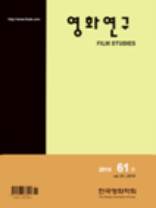- 영문명
- A Study on Formation of the Concept of Cultural Film in Colonial Korea
- 발행기관
- 한국영화학회
- 저자명
- 정종화
- 간행물 정보
- 『영화연구』제61호, 271~296쪽, 전체 26쪽
- 주제분류
- 예술체육 > 예술일반
- 파일형태
- 발행일자
- 2014.09.30
5,920원
구매일시로부터 72시간 이내에 다운로드 가능합니다.
이 학술논문 정보는 (주)교보문고와 각 발행기관 사이에 저작물 이용 계약이 체결된 것으로, 교보문고를 통해 제공되고 있습니다.

국문 초록
영문 초록
This paper aims to examine the origin of cultural film and theformation of its concept in the face of the enforcement of film policy inimperial Japan and colonial Korea. As this paper focuses on, theterminology of cultural film was not only the outcome from anambivalent project which imperial Japan tried in both imperial Japan andcolonial Korea before 1945, but also the fruit of the colonial modernitywhich colonial Korea received as re-translated from Western Germany viaJapan. This equivocal term of cultural film and its difficulty to define hadbeen a problematic post-colonial issue which continued from the colonialperiod to post-war and even to the first enactment of the Film Law inJanuary, 1962 in South Korea. The cultural film originates from ‘Kulturfilm’ produced by WesternGerman UFA (Universum Film AG) including Wege zu Kraft undSchönheit (Golden Road to Health and Beauty) (1925), which imperialJapan imported and translated. It was the import and release of a UFAKulturfilm by Towa Corporation around 1936 that had a great influenceon Japanese society. And the terminology of cultural film which imperialJapan translated to started to be used in colonial Korea as itself. Thisterm became influential to the extent that it was to be legislated in theFilm Law in Japan in October, 1939 and in the Chosun Film Regulationin August, 1940. The cultural film was confirmed by ‘approval’ of Minister of Culture and Education in imperial Japan and Governor-General of colonial Korea in colonial Korea. Moreover, its way ofpractice was exposed as ‘compulsive screening.’ The cultural filmreceived attention as ‘enlightening propaganda film’ which “plays a veryimportant role of instructing our nation in how to accomplish our missionof the Greater East Asia War,” as Mihashi Aiyoshi, a civil servant forsocial education of the Ministry of Culture mentioned
목차
1. 들어가며
2. 문화영화의 역사적 기원
3. 식민지기 문화영화 법제와 그 담론
4. 나가며
키워드
해당간행물 수록 논문
- 한국영화의 해외시장 진출을 위한 콘텐츠 전략 연구
- 디지털 융합 환경에 따른 대학영화교육 패러다임의 변화에 대한 연구
- 식민지기 조선의 문화영화 개념 형성에 관한 연구
- Female Sexuality in Kim Ki-duk’s Moebius: Going Beyond Freud and Lacan
- 문학과 만나는 영화의 한 방식
- 영화제작의 리스크관리를 위한 스토리공학적 접근
- The Development of Chinese Film Industry in the Deng Era
- 영화 공간 사운드 제작연구
- 미래 영화관 개발의 대안 책으로서 <록키호러픽쳐쇼>의 영상과 퍼포먼스의 확대영화에 대한 논의
- 융합학문으로서의 ‘영화공학’의 학적 성립과 방향
- 영화연구 제61호 목차
- 디지털 특수효과로서 카메라 무브먼트(movement)에대한 고찰
- 신화적 모티브의 영화적 재구성에 관한 연구
- Wiederholte filmische Motive zur Erinnerung der Vergangenheit und ihre Bedeutung als kultursemiotischer Code im koreanischen Film
- 리좀적 탈주로써 ‘-되기’ 생성 연구
- 현실에 대한 저항과 전복, 민족의 정체성 탐구, 브라질의 시네마 누보(1955-1971)
- 철학과 물리학의 통섭적 시각으로 살펴본 영화 <마법사들>의 시⋅공간
- 1970∼80년대 민중문화운동과 한국영화
참고문헌
관련논문
예술체육 > 예술일반분야 BEST
- 생성형 AI 도구와 디자이너의 협업 프로세스 개발 - 이미지를 통한 아이디어 확산에서 고해상도 렌더링까지
- ‘일과 삶의 균형(Work-Life Balance)’ 척도 개발을 위한 연구
- 디자인 전공 교과목에서의 생성형 AI 도구 활용 사례 연구
예술체육 > 예술일반분야 NEW
- 한국영화의 촬영과 조명 시리즈 2: 영화 '형사, Duelist'의 Visual Concept 및 조명플랜
- 포스트모더니즘적 영상표현에 관한 연구 -실사 영화와 애니메이션 영화의 상호작용을 중심으로-
- 소니 HVR-Z1N 카메라의 중요한 메뉴에 관한 소고
최근 이용한 논문
교보eBook 첫 방문을 환영 합니다!

신규가입 혜택 지급이 완료 되었습니다.
바로 사용 가능한 교보e캐시 1,000원 (유효기간 7일)
지금 바로 교보eBook의 다양한 콘텐츠를 이용해 보세요!



